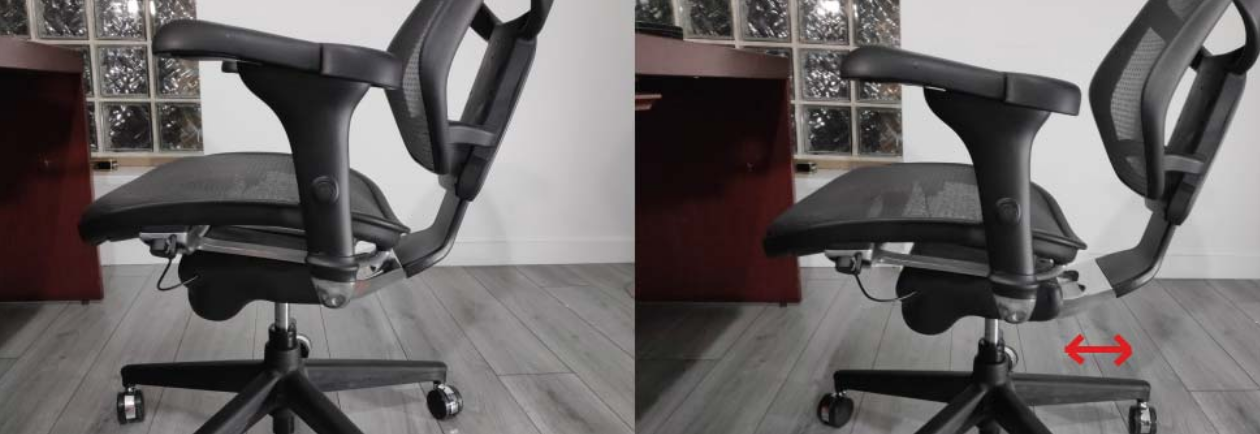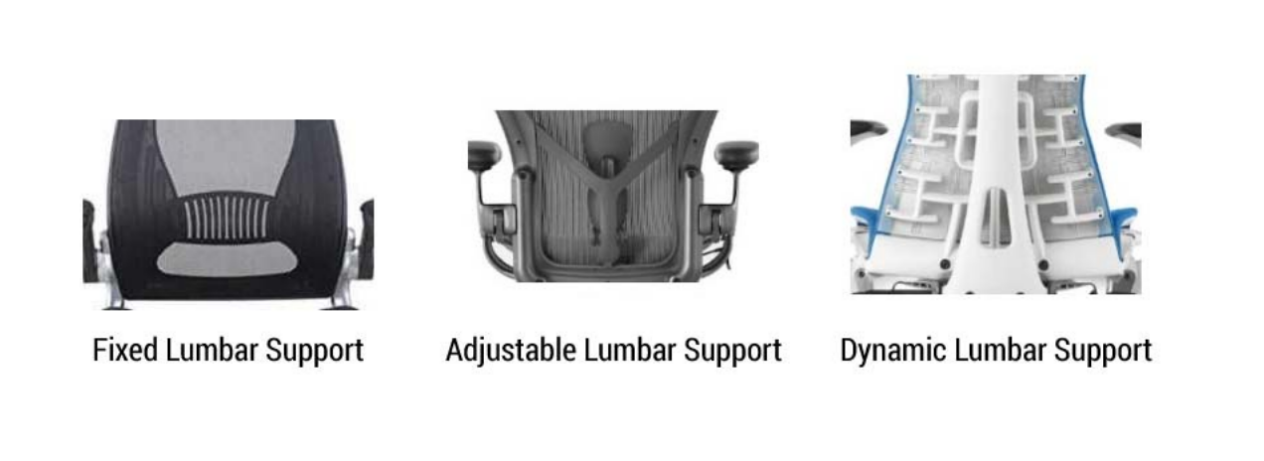By Pompey | 25 September 2021 | 3 Comments
Experiencing back pain at work? Ergonomic Office Chairs: Your Solution to Wellness and Happiness
In the modern-day, employees sit at their desks during a 9 to 5 workday, the majority of which is spent uninterrupted and without breaks. Besides, 95% of the time at the office is spent in front of a computer or other electronic devices. The busy work-life at offices leads to people underestimating the importance of ergonomics. At times, people forget that their bodies would have to endure physical, psychological, and repetitive stress. Those who sit on non-ergonomic office chairs are bound to feel uncomfortable and be exposed to ergonomic hazards, which are often unnoticeable. In contrast to traditional hazards, an ergonomic hazard is a situation or behavior that can lead to musculoskeletal disorders (MSDs). These actions are repeated over time and will result in painful injuries or ailments. The common ergonomic hazards include inadequate or worn-out chairs, poor posture due to device placement, and prolonged periods of sitting.
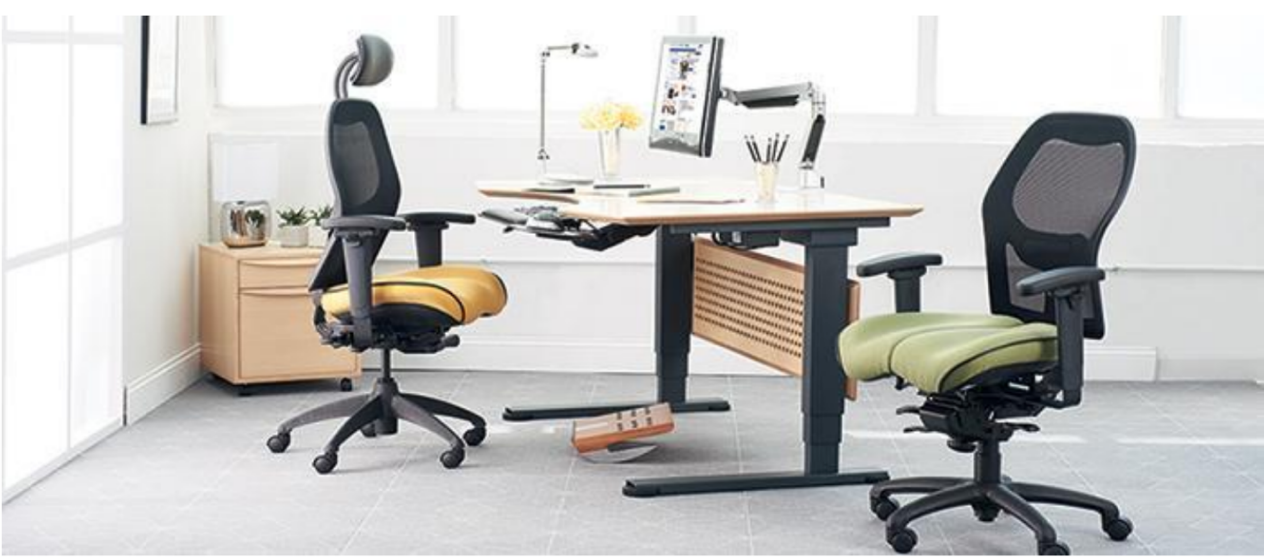

Ergonomic Office Chairs (Sourced from Haznet)
What is an Ergonomic Chair?
Ergonomics is a science known as human engineering or biotechnology. An ergonomic chair is a chair designed to best support the human body, taking into account factors such as posture, comfort, support, and health. It is meant to adapt to the users’ needs and is linked to increased productivity due to the customized support. It is made up of 5 to 9 adjustable components, including:
1. Adjustable headrest
2. Lumbar Support
3. Adjustable arm width
4. Adjustable arm height
5. Adjustable seat pan
6. Chair height adjustment
7. Adjustable tilt tension
8. Tilt lock

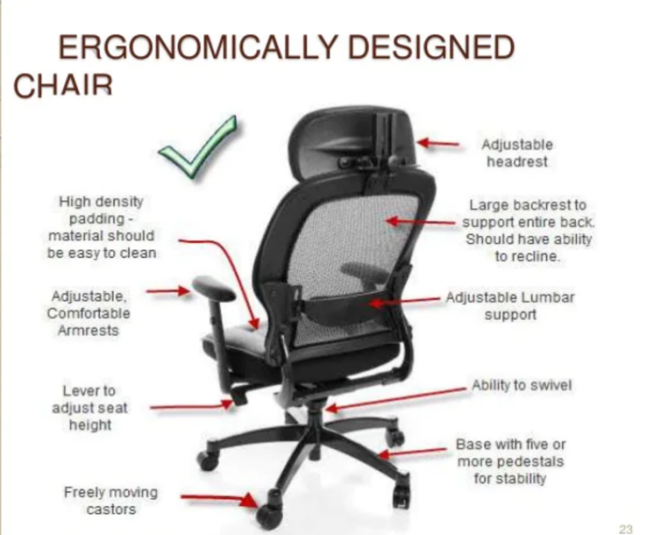
Adjustable Components of an Ergonomic Chair (Sourced from Ergonomic Trends and Safe Computing Tips)
Sitting is considered a specialized activity in the ergonomics approach, and it is influenced by how a sitting person interacts with the working environment. Ergonomic chairs are designed to fit a range of people, but there is no guarantee that they suit everyone. For example, a chair could be too high, and the armrests are too far apart for a short, skinny person. Therefore, it is important to find the right chair by considering the employee’s body dimensions and height, as everyone might have different torso-to-leg ratios. This can also ensure that the chair does not strain one part of the body.
Why are ergonomic office chairs important?
1. Encourage Good Posture

Poor Sitting Postures and Good Sitting Posture (Sourced from Tech & Q Furniture)
We would sit in odd positions and be accustomed to slouching to be comfortable in a normal office chair. Our legs might be dangling from the chair or spread out under our desks, or we tend to lean forward because those chairs do not have the correct back height. This leads to bad posture, which contributes to poor health. Ergonomic office chairs are designed to support natural posture and lessen the stressful forces on our bodies. The chair backs are full length extending from our shoulders to the seat. The lower back has a portion that curves forward slightly to match the natural curve in our lumbar spine, which is referred to as lumbar support.
2. Health Benefits
2.1 Reduced pain
A well-designed ergonomic office chair will reduce the stress on the musculoskeletal system that causes strain on the neck, shoulders, and back by providing a good posture that brings long-term health benefits. It does more than just relieve pain. Back problems such as osteoporosis, scoliosis, or cervical spondylosis can be avoided. Ergonomic chairs have backrests that are adjustable and separate from the seat. You can adjust how far the backrest should be, whether it should move with you or provide additional support, and how high the backrest should be. The backrests can be extended high enough to support your whole back, facilitating the even distribution of pressure throughout your entire back. Neck and shoulder pain can be relieved as some ergonomic office chairs come with additional neck rests, which can ease the strain of needing to hold your head up all day. In addition, backrests can extend high enough to support the shoulders, reducing stress and suffering throughout the day.
The improper alignment of the hips and pelvis is a major cause of low back pain while sitting. Consider your pelvic top as a bowl of soup that needs to be kept level to avoid spilling forward or backward. Bony structures on the pelvic bones called the anterior superior iliac spine (ASIS), and the posterior superior iliac spine (PSIS) should be level relative to each other when sitting in the proper position. The ASIS and PSIS are located on the front and back of the pelvic bones, respectively. When these bony structures are level, your low back should have a slight arch facing forward convex part. To sum it up, pressure on hips or buttocks can be reduced. Ergonomic chairs are designed to be sturdy and comfortable enough to relieve the pressure on your hips and buttocks caused by sitting. Furthermore, less of your body’s weight will be forced onto your lower body if you have more back support.
The improper alignment of the hips and pelvis is a major cause of low back pain while sitting. Consider your pelvic top as a bowl of soup that needs to be kept level to avoid spilling forward or backward. Bony structures on the pelvic bones called the anterior superior iliac spine (ASIS), and the posterior superior iliac spine (PSIS) should be level relative to each other when sitting in the proper position. The ASIS and PSIS are located on the front and back of the pelvic bones, respectively. When these bony structures are level, your low back should have a slight arch facing forward convex part. To sum it up, pressure on hips or buttocks can be reduced. Ergonomic chairs are designed to be sturdy and comfortable enough to relieve the pressure on your hips and buttocks caused by sitting. Furthermore, less of your body’s weight will be forced onto your lower body if you have more back support.
2.2 Improve blood circulation
A chair can affect the blood flow in your body if it is not appropriately adjusted. For example, you spend time sitting on a too high chair for your feet to touch the ground, preventing the blood flow through your legs. This will cause problems such as blood clots, tingling, and cramps. Ergonomic chairs serve to provide comfort, allowing you to sit with your feet on the ground. A lesser-known fact is that adjusting our seat to a 90-degree allows proper circulation, and ergonomic chairs are built for that! When we are in the mood to stretch, it can recline and return to its upright position. Therefore, ergonomic chairs ensure better circulation and minimize swelling and numbness in your legs.
3. Improves Employee Wellness
Employee wellness encompasses not only their physical well-being but also their mental health. For example, many people who experience back pains at work are also coping with an unpleasant feedback loop called the pain cycle. This is the discomfort from back pains that causes psychological stress, preventing them from engaging in physical activity and intensifying the pain, leading to more stress. It will affect the employee’s mental health in the worst-case scenario, resulting in depression and anxiety, leading to greater back pain. Investing in employee’s well-being and health through ergonomic office furniture would mean that the employer cares about the employees. As a result, the employees would feel appreciated, respected, and cared for. This will increase in happiness, well-being, motivation, and pleasure at the workplace as they feel less stressed, leading to improved productivity, efficiency and performance.
4. Boosts Morale
Employees notice when their employer goes beyond to protect their health and safety. If the employees do not experience fatigue, discomfort, or pain during working hours, it can reduce absenteeism and turnover, improve morale, and increase employee involvement and engagement. This will cultivate a strong partnership and trust between the employers and employees and build engagement rapport in the workplace.
5. Boosts Productivity
Research shows that people are 17.5% more productive when working in an ergonomic setting, and studies have proven that there is a strong correlation between productivity and comfort. If it is correctly implemented, it can improve productivity from 10% to 15%. On the other hand, poor ergonomics will lead to frustrated and fatigued employees who might not give their utmost effort or try their best to complete their tasks, especially when the tasks are too physically taxing. There will be fewer distractions by providing ergonomic chairs, which can improve focus, allowing them to finish work at a faster pace, boost problem-solving skills and overall creativity. Besides, this will facilitate more engagement and contribution, which will lead to improved work quality and office workflow.
6. Improved comfort
Ergonomic chairs are made with higher quality materials than budget office chairs. The materials should not cause your back to sweat. However, the materials used will be determined by the budget. For example, high-end ergonomic chairs will be made of leather or velvet. To improve the fit, the seat and back cushions could be thicker or molded. Additional lumbar support is implemented to the design. If your legs are shorter, you can reduce the seat depth by lowering the chair and sliding the seat back forward. If you have a long torso, the armrests can be lifted to support your elbows. The bottom line is that ergonomic chairs are more comfortable than any other option unless you have found some alternative method to work sustainably and comfortably in bed for extended periods. Ergonomic office chairs promote a higher sense of physical and emotional relaxation by accommodating your body type and assisting you in focusing. Thus, the workday becomes more doable, and sitting becomes less stressful.
7. One Chair Fits All
Body types vary for every individual, so it is essential that a chair can accommodate your body measurements. Ergonomic chairs come in various shapes and sizes, including anywhere from four and eight points of adjustment. Ergonomic chairs can be customized to meet your physical specifications regardless of your size, torso length, and natural arch of your spine.
8. Establishes a safety-oriented culture
Providing ergonomic office chairs will show the company’s commitment to safety and health as a core value. Apart from the negative impacts caused by poor ergonomics mentioned above, employees might also encounter other workplace injuries. Ergonomic chairs can minimize the incidents of injuries caused by poorly designed office chairs. Besides, ergonomics can increase awareness and understanding, leading to a safety-oriented culture. Therefore, they will be more careful and will not neglect their health. Bear in mind that healthy employees are the company’s most valuable asset as they play a role in contributing to a company’s success. Creating and fostering a healthy culture within your company leads directly to increased organizational structure and better employee performance.
9. Ergonomic office chairs reduces costs
An ergonomic office chair is an investment. Even though a considerable amount is needed, it is worth it in the long term as the benefits outweigh the costs. This will allow you to reduce costs related to a significant aspect of the company: employee health. It can help cut down on workers’ compensation costs and claims as work-related injuries can be prevented when implemented properly. Direct costs for a company include workers’ compensation payments, medical expenses, and legal service fees. There are also indirect costs, including implementing corrective measures, accident investigation, lost productivity, training replacement employees, and absenteeism. According to the Occupational Safety and Health Administration (OSHA), the indirect costs can be up to 20 times higher than direct costs. Ergonomic office chairs will reduce MSDs. Implementing ergonomics can help reduce direct costs and indirect costs by 60-90 percent. In addition, the number of work-related injuries will decrease. This means that employees will spend more time at offices than being on leave due to illness and injuries that arise. Fewer workers’ compensation cases result in lower medical expenses, reduced need for legal services, and less risk for paying large financial settlements. By taking care of your employees’ health, it will bring higher rates of workplace happiness. Hence, placing sufficient funds for ergonomic office chairs can preserve both your employees’ health and your company’s funds simultaneously.
How to adjust an ergonomic chair?
Once you selected your chair, it is crucial to learn how to adjust your chair. Here are some valuable steps to help you learn and adjust the chair to fit your body best.
Seat Height
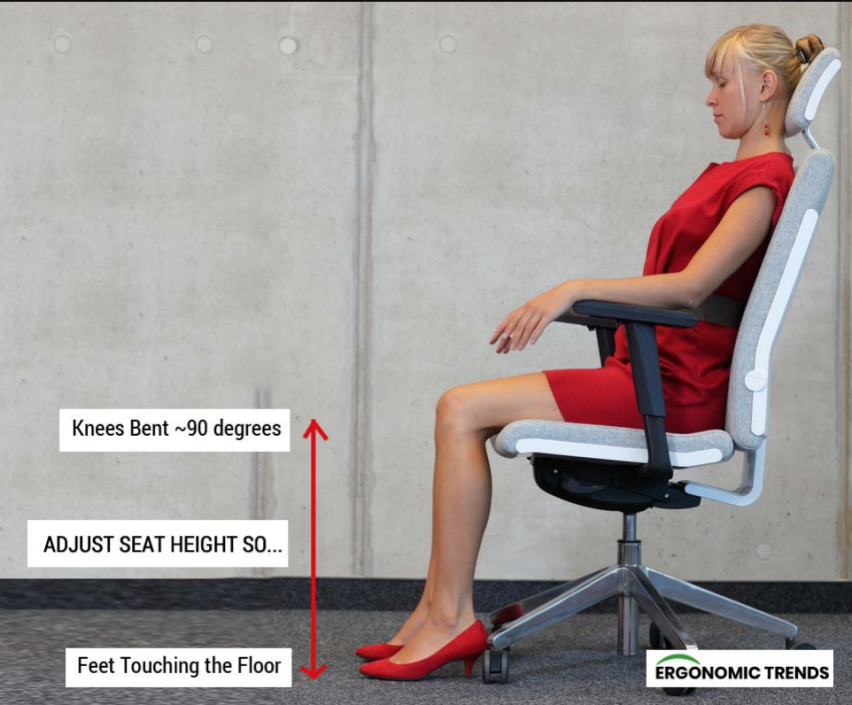
How to Measure Seat Height (Sourced from Ergonomic Trends)
The first step is getting your chair adjusted to your body. When you sit, the ideal seat height must be firmly touching the floor, and your knees should be bent at a 90-degree angle. Measure the length from the top of your knees to the soles of your feet to see if the height of the ergonomic chair will fit you. Next, sit in your chair with your back firmly against the chair back and adjust the seat cylinder to the proper height. Alternatively, stand in front of the chair and adjust the height so that the top of your seat is below your knee cap.

Calculating Ideal Seat Height Sitting Up (Sourced from Ergonomic Trends)
Seat Pan Depth
Seat Depth Adjustment (Sourced from Ergonomic Trends)
| |
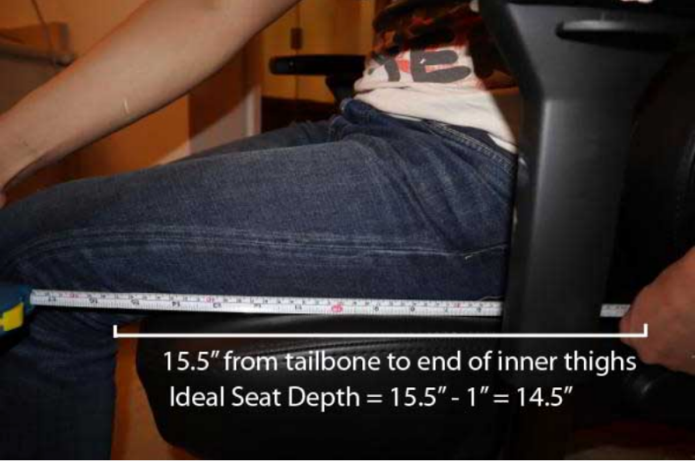
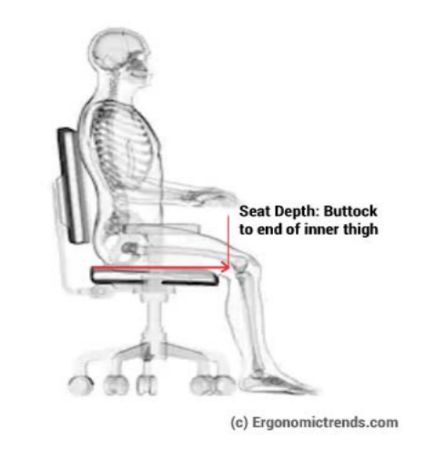
Seat Depth Adjustment (Sourced from Ergonomic Trends)
Seat pan depth is measured as the horizontal distance between your buttock and the back of your knees. Your body will be appropriately positioned in the seat against the chair’s backrest if the seat pan depth is correct. If the seat pan depth is too short, a large part of your knee will be unsupported. In contrast, a long seat pan will prevent your back from fully resting on the chair’s backrest, putting excessive strain on the ends of your thighs. A shorter person will prefer a seat closer to the chair back, whereas a taller person will prefer one further away.
A seat pan depth of between 17” to 21” fit most people. Ergonomic chairs with a 2” seat depth adjustment are great for accommodating various sitting positions. Ultimately, the perfect seat pan depth is where 2-3 fingers separate the edge of the seat and your inner thighs.
Armrests
Our arms, along with our hands, account for about 10% of our entire body weight. Fundamentally, strong-arm support in a chair is critical for mitigating the strain on our shoulders in the seated position. Armrests should be positioned just beneath where our arms end while sitting with our hands on the desk and maintaining good posture. Some conventional office chairs have armrests that are too far apart, which can lead to poor posture. Armrests should be long enough to accommodate the forearm fully. Otherwise, they are useless. Armrests should be both height adjustable and width adjustable, which allows a more customized fit to our body. You should be able to elevate them to the height of your workstation or desk (typically 29”) so that your arms can be parallel to the desk. Armrests that can be lowered to tuck the chair under the desk are also useful if you are short on room. Armrests with pivots can also be found on good ergonomic chairs. This means that they can be angled both inwards and outwards (up to 30 degrees). Pivoting armrests are essential to support your forearms when your hands are close to each other relative to your elbows.
Headrest
An ergonomic chair with a headrest must be adjusted well. Headrests support and comfort your head and neck in a reclined position, maintaining your head at a near-constant eye level with your computer monitor. There are many types of headrests, including built-in, height-adjustable, and fully adjustable.
Lumbar Support
Types of Adjustable Lumbar Support (Sourced from Ergonomic Trends)
The lumbar support must be adjusted to fit comfortably in a person’s lumbar area. It must be raised high enough to fit against the lumbar and thoracic spine, typically at the small of your back directly above your belt line, as well as far enough forward to prevent them from having to lean back to get backrest support. If they find that the backrest no longer supports them, the seat pan may be too large, and they will need to switch chairs. This adjustment is often built into the chair, allowing you to change the chair back and lumbar support simultaneously.
Backrests
1. Angle Adjustment
The backrest angle can be altered by tilting or reclining. Different tilt mechanisms in ergonomic office chairs will result in different experiences in comfort. The backrest and seat recline at a 2:1 ratio in a synchronous tilt, allowing your lower body and gaze horizontal when leaning back. A good chair tilt is to the slouched posture of 100 degrees to 110 degrees. This mechanism reduces seat pan rise as you tilt, allowing you to keep your feet on the ground while remaining your gaze straight ahead. It also stretches the chest without putting excess pressure on the thighs.
The reclining mechanism is controlled entirely by the backrest, unlike the tilting where the mechanism is built underneath the chair. So essentially, the angle that can be achieved is must greater. Some reclining office chairs even recline almost horizontally, allowing you to take brief naps at work.
The reclining mechanism is controlled entirely by the backrest, unlike the tilting where the mechanism is built underneath the chair. So essentially, the angle that can be achieved is must greater. Some reclining office chairs even recline almost horizontally, allowing you to take brief naps at work.
2. Height Adjustment
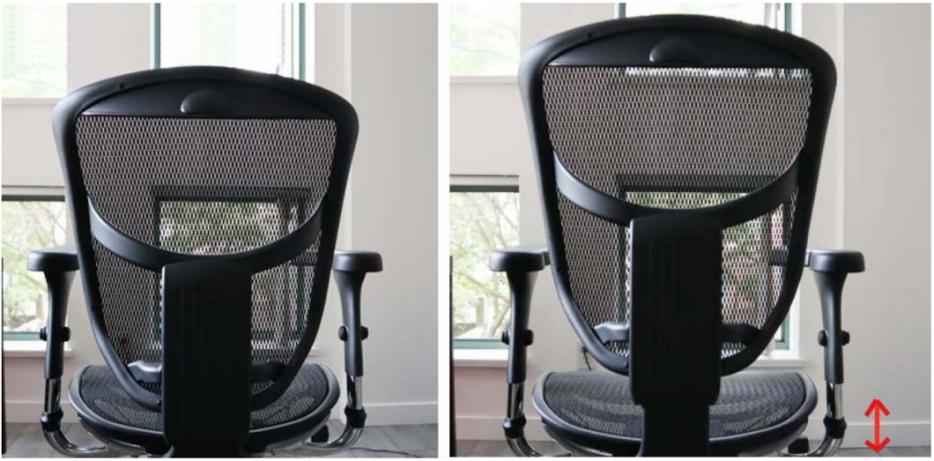
Height Adjustable Backrest (Sourced from Ergonomic Trends)
The backrest height adjustments provide proper lumbar back support to promote correct posture and fit the spine’s curvature. Move it to the exact height where your back is most supported. However, this is different from the adjustable lumbar support, which focuses solely on the lumbar area and not the rest of your back.
Conclusion
Ergonomic chairs are just part of the solution. There are several ways to improve ergonomics at offices. Remember that your employees are a company’s valuable assets, so please take into account their health and well-being. We have emphasized the importance and benefits of ergonomic office chairs in this article and hope this guide can be helpful. We wish you a happy and healthy work-life!
Recently Reviews
Read MoreLeave a Reply
Your email address will not be published.Required fields are marked. *
CATEGORIES
POPULAR BLOG
- How Much Does An Office Chair Cost in 2022
- Office Chair Buying Guide: How to Find the Perfect Office Chair for Your Office?
- How to Import Office Furnitures from China: The Complete Guide
- 15 Most Popular Ergonomic Office Chairs on the Market Under $500 for Your Office in 2022
- The Ultimate Guide of Top 10 Chinese Office Furniture Manufacturers in 2022
